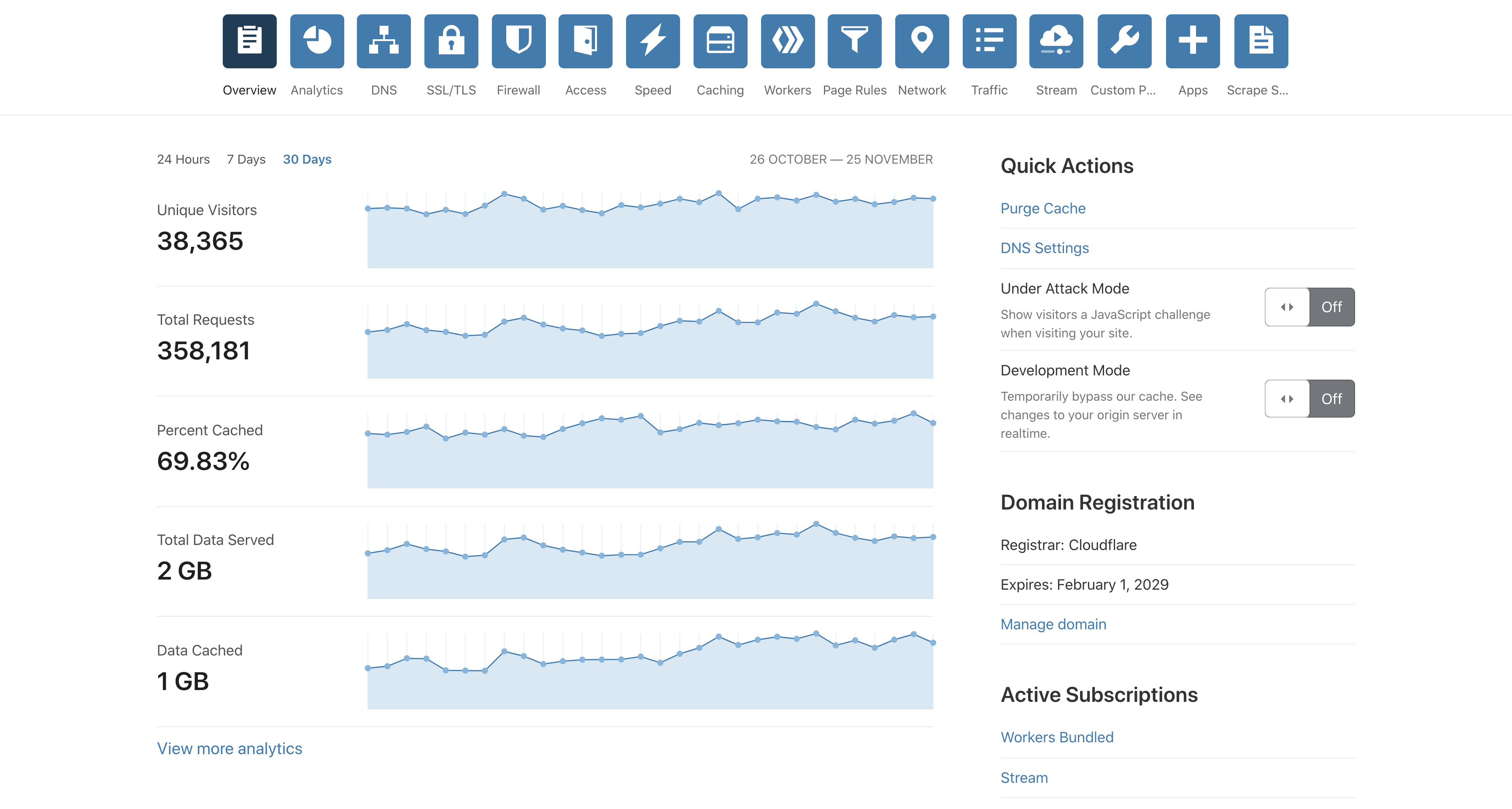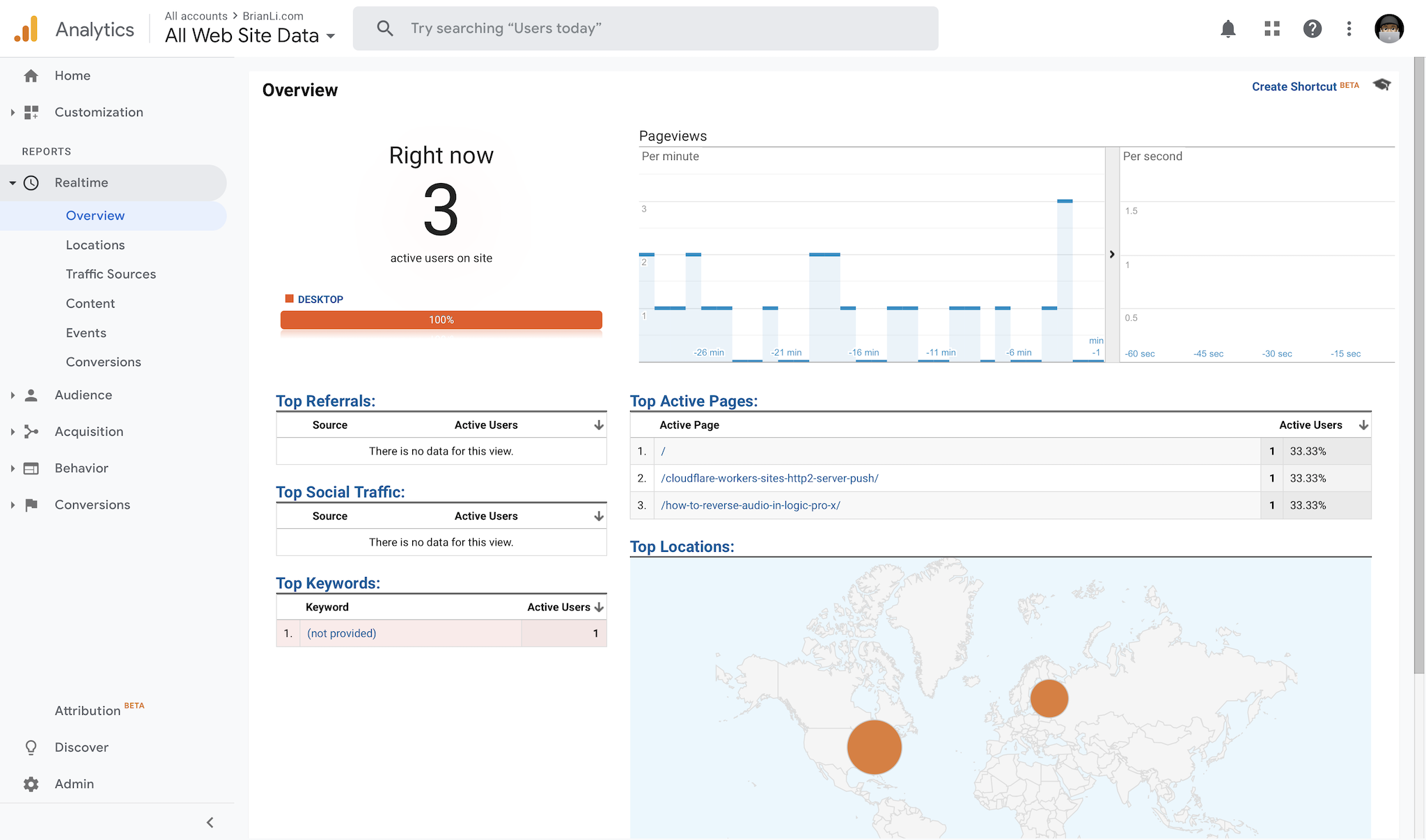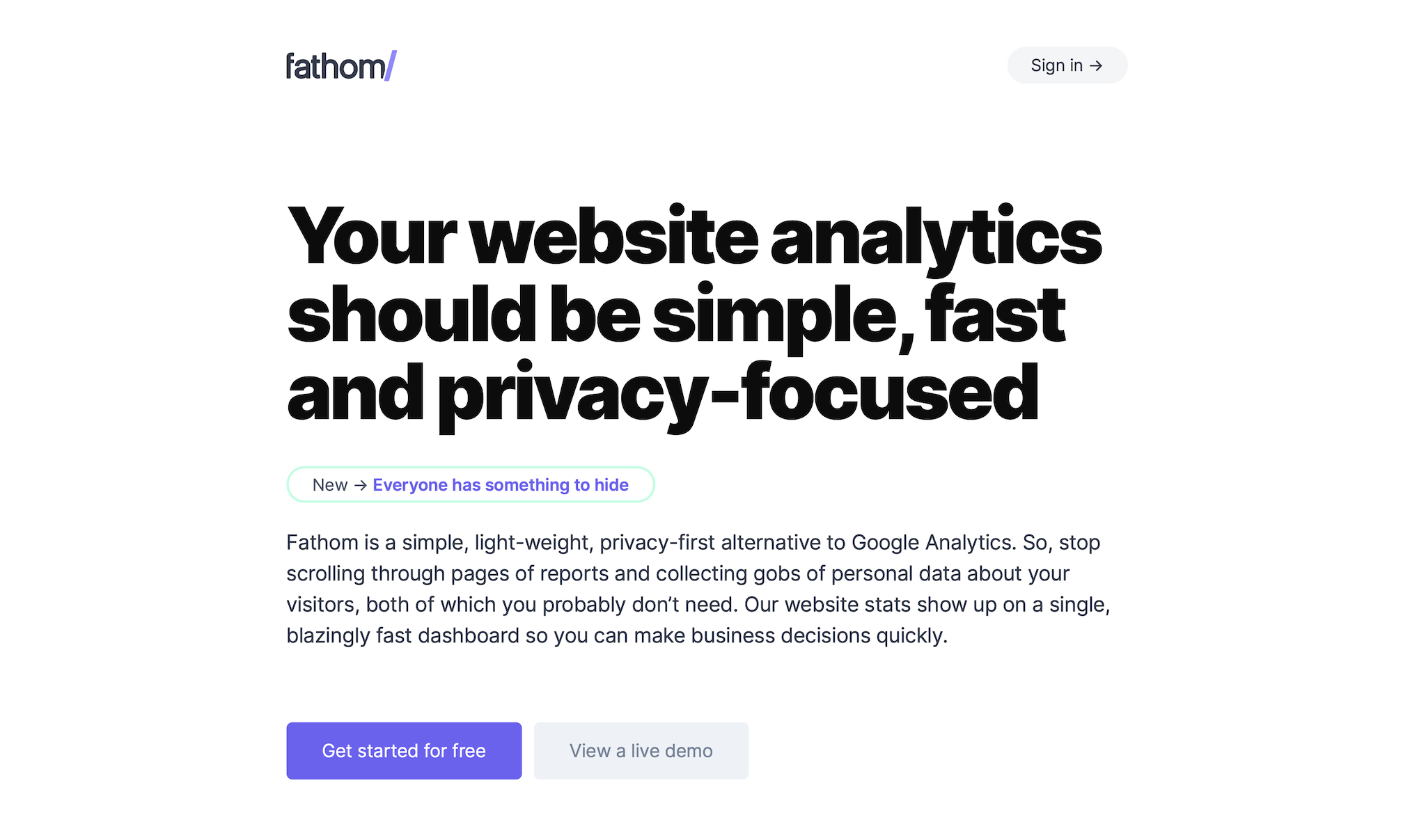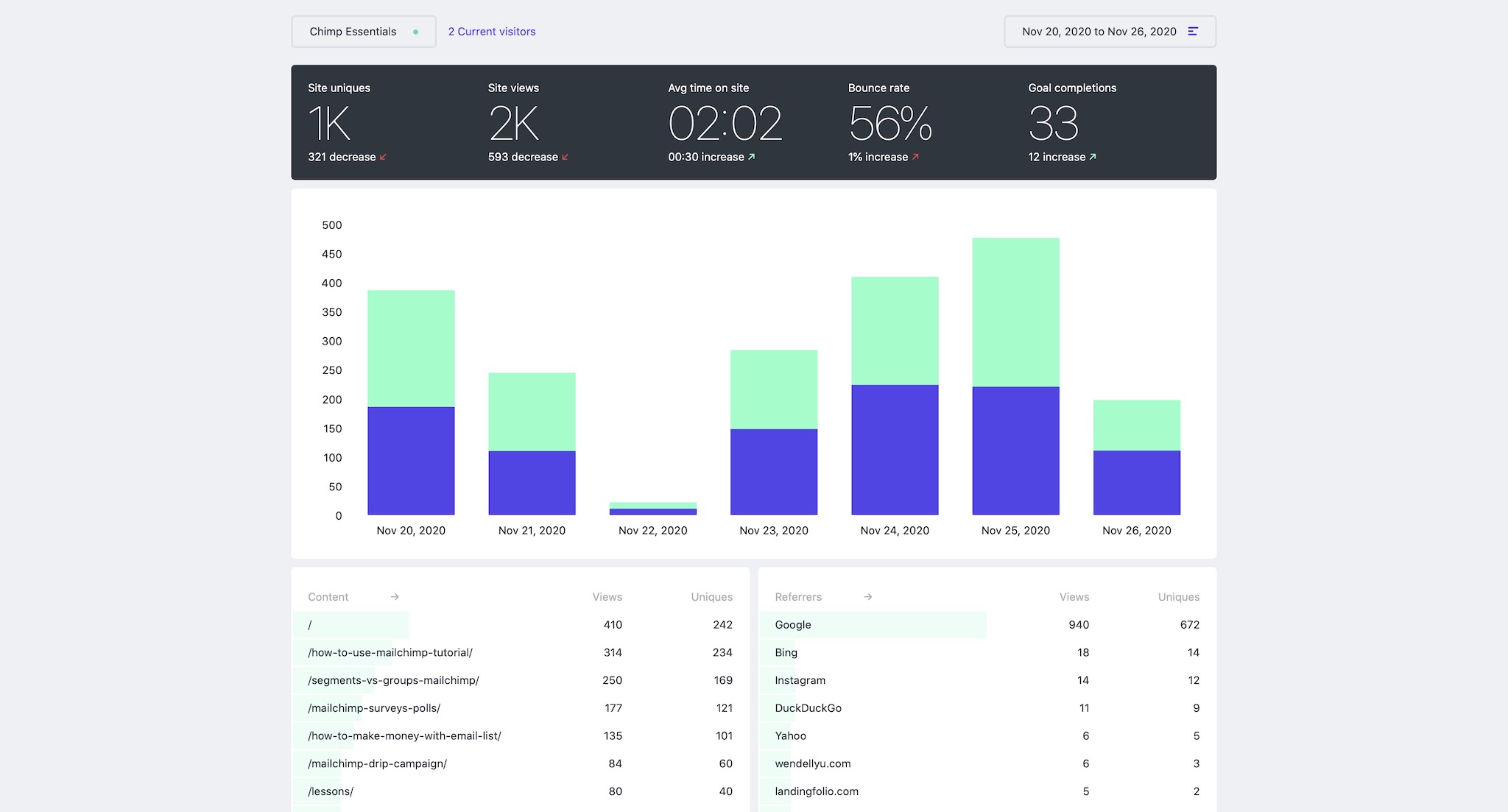In 2023, there are dozens of web analytics services to choose from. All of these services help you track, to different extents and in different ways, the activity of visitors to your site. In this post, you’ll learn about the similarities and differences between Google Analytics, Fathom Analytics, and Cloudflare Analytics, so you can decide which analytics solution to use for your site.
Are Website Analytics Necessary?
Before we dive into which analytics service to choose for your site, let’s first discuss whether you even need website analytics at all. While some people may view this question as a rhetorical one, I don’t think it’s so clear cut. I’ve started numerous websites and web projects over the years, and the final step before revealing them to the world was always integrating the Google Analytics tracking code. I never stopped and asked myself why I automatically added Google Analytics to everything. It was just something I did.
It wasn’t until this year that I started questioning myself about why I was so keen on adding analytics to everything I did. This sudden case of analytics introspection was born out of my blossoming interest in privacy. In 2020, a bunch of the people I follow online wrote about switching from Google Analytics to Fathom Analytics, so that got me thinking about how I use analytics services.
Here’s what I found – out of my five active web properties, the only one I cared about from an analytics perspective was my personal blog. The other projects had years of data which I haven’t looked at since 2017. So, this brings us back to the question of whether website analytics are even necessary in 2020. If you asked me this question in 2010, I most likely would’ve said, “Yeah, it’s better to have data just in case!”. In 2020, my answer to this question is simply, “No. I don’t think analytics are necessary for every single website out there.”.
The necessity for an analytics service depends on the purpose of your site. If you’re running a business where analyzing metrics like “time on page” and “bounce rate” are crucial from a competitive standpoint, you definitely need to use analytics for sure. On the other hand, if you’re running a low-stakes site and have no intention of making strategic data-influenced changes, don’t waste your time and, more importantly, mental bandwidth on web analytics.
Voluntary vs. Involuntary Web Analytics
With that said, I think there are certainly some edge cases to consider – not everyone fits into the “business that needs analytics” and “hobbyist blogger who doesn’t need analytics” categories. For many site owners, a positive trend in visitors can be super motivating. There’s nothing like finding out one of your posts went viral. For this kind of use case, I’d recommend using an involuntary web analytics solution instead of a voluntary one.
Now, you’re probably wondering what I mean when I say “voluntary” and “involuntary”. This is by no means an industry standard term, so let me explain. A voluntary analytics solution is something like Google Analytics or Fathom Analytics. It’s a service that’s not bundled with your site infrastructure, and requires you to add tracking code to your site voluntarily.
An involuntary web analytics solution is one that’s either included with your DNS or web hosting provider. It doesn’t require you to sign up for an external service and add tracking code to your site. Involuntary solutions are typically less precise and granular than voluntary solutions, but they work just fine for identifying trends and spikes, which are the two most important metrics for site owners who don’t want to dig into the granularity of Google Analytics or Fathom Analytics.
Kinsta, a managed WordPress host, provides a detailed analytics dashboard that shows metrics like visits and bandwidth. Kinsta’s web analytics are involuntary because they’re sourced from raw server logs, and don’t require you add JavaScript tracking code to your site.

Web analytics in the Kinsta dashboard.
Similarly, Cloudflare’s proxy analytics is another example of an involuntary solution. If your site is proxied by Cloudflare, you have access to general analytics data like “unique visitors” and “total requests” in the Cloudflare dashboard without having to install any tracking scripts.

Cloudflare's dashboard displays visitor analytics.
For most users, involuntary analytics are much better than voluntary solutions. The majority of bloggers and site owners out there simply don’t need the granularity of Google Analytics or Fathom Analytics. Instead, they just want to know if their site traffic is growing over time.
Thus, using an involuntary analytics solution like Cloudflare’s proxy analytics or host’s built-in analytics dashboard helps you cut out the “noise”, while retaining the “signal”. To put it simply, if you need a more advanced solution like Google Analytics or Fathom Analytics, you’ll know it.
Google Analytics
Google Analytics is the undisputed leader in web analytics. According to W3Techs, over 54.7% of all websites use Google Analytics to track visitor metrics! Google Analytics is so popular for two major reasons.
- Google Analytics launched in 2005, and there weren’t many options for analytics solutions back then. As with many products in many industries, first movers are often able to eat up significant market share.
- Google Analytics is an excellent service and it’s free to use.

Google Analytics is a popular free analytics solution.
Pros of Using Google Analytics
Google is an advertising company, which means it probably has some amazing analytics software and intellectual property locked up in its headquarters. Some of these innovations have undoubtedly made their way into the public and free-to-use Google Analytics service, and it shows. Say what you want about Google’s questionable history when it comes to privacy, Google Analytics is still best-in-class at the end of the day from a data and metrics standpoint.
So, I think there are two pros of using Google Analytics. First, it’s free to add to your site, which is very important. Fathom Analytics, which we’ll discuss later on, starts at $14/month and the pricing model scales up based on page views. Google Analytics, on the other hand, is free whether you have 100,000 or 10 million monthly page views. For many bloggers, $14/month is definitely not pocket change, so having access to a high-quality and free service like Google Analytics can be very helpful.
The second pro of using Google Analytics is access to a large number of website metrics. In addition to basic data points like “most visited page” and “time on page”, Google Analytics also provides you with other metrics like “behavior flow”, user device breakdowns, demographic data, and more. For businesses, this detailed data can be helpful for making strategic decisions that impact revenue.
Cons of Using Google Analytics
Suprisingly, or maybe not, the cons of using Google Analytics are similar to the pros. For certain classes of users, a free analytics service is a nightmare instead of a dream come true. As with other free Internet services like Gmail, Facebook, and Twitter, you are the product. Some people don’t view this as an issue, while others do. In other words, if you’re someone who is concerned about preserving and prioritizing your privacy, as well as the privacy of visitors to your site, then Google Analytics is not the right choice for you.
For most users, the large array of data metrics available in Google Analytics can actually be a productivity hinderance instead of an enabler. Contrary to popular belief, Google Analytics isn’t easy to use at all. In fact, I think it’s much easier to misuse Google Analytics than to use it correctly.
Consider the following example.
You’re new to blogging, and decide to install Google Analytics on your site because some WordPress guru on YouTube told you to do so. After installing the tracking code, you let Google Analytics collect data for a week. Upon reviewing the data, you find that your site has an “average time on page” of one minute. You do some research online, and stumble upon some random Internet stranger who tells you it’s better to aim for an average time on page of two minutes or more.
You see where I’m going with this, right?
Parsing and analyzing Google Analytics data requires an innate understanding of how various metrics apply to the context of your site. In the example above, an average time on page of one minute is not necessarily a bad thing because it completely depends on the purpose of your site. For example, if your site gives tips on how to help a choking infant, a low average time on page is actually a good thing! On the other hand, if you write in-depth research articles about microbiology, then an average time on page of one minute is concering.
Simply put, too much data isn’t necessarily a good thing. If you don’t have the skills or experience to analyze Google Analytics data in different contexts, you can easily end up going down a rabbit hole optimizing your site based on an incorrect understanding of analytics data. So, if you’re someone who doesn’t care about data granularity, just skip Google Analytics and choose a WordPress host or DNS service that provides you with just enough data to help you determine whether your traffic is increasing or decreasing.
Fathom Analytics
Over the past two years, we’ve witnessed the birth of a number of privacy-oriented analytics solutions. My favorite one thus far, and perhaps the most established option, is Fathom Analytics. Compared to Google Analytics, Fathom Analytics bills itself as a simpler, faster, and privacy-first alternative.

Fathom Analytics provides privacy-focused web analytics.
The main selling point for Fathom Analytics is digital privacy, and here’s what they have to say about this very important topic.
You may think that digital privacy doesn’t matter because you have nothing to hide. And that may be true (to some extent), but your data shouldn’t be monetized and sold by huge tech companies who are taking your tastes and preferences and selling them to advertisers (including companies like Cambridge Analytica). These companies are following you around the internet, keeping track of what you do, and then using that knowledge to sell you things or manipulate your thoughts.
By using Fathom, you are making your website a black hole to big tech, meaning they cannot track any data about individuals who visit your website. Not to mention, we are GDPR, CCPA and PECR compliant.
What Fathom says is completely true. Digital privacy is not about having nothing to hide at all. In some ways, that response is irrelevant. The main issue is unethical monetization of your data in a business model where the providers of said data (you) only receive limited upside.
Pros of Using Fathom Analytics
Preserving user privacy is the main pro of using Fathom Analytics. Unlike Google Analytics, Fathom Analytics doesn’t use cookies to track visitors as they make their way across the World Wide Web. Practically speaking, a cookie-free service like Fathom Analytics can also provide a better user experiece for visitors.
For example, in Safari 14, Apple introduced a number of privacy-oriented features including a new shield icon in the menu bar, which alerts users of embedded trackers on web pages. For Safari users who aren’t plugged into the latest developments and trends in web privacy, seeing a message like “1 tracker prevented from profiling you” can degrade perception towards your brand.

New privacy features in Safari 14.
Sites using Fathom Analytics don’t have to worry about Safari’s privacy shield affecting user experience because there are no tracking or profiling alerts to speak of when using Fathom Analytics.
A simple and streamlined dashboard is another reason to use Fathom Analytics. As I mentioned before, having access to large swathes of data isn’t an advantage for everyone. There is a serious case to be made about minimizing the number of accessible metrics to cut through the noise, and that’s exactly what Fathom Analytics does. Fathom Analytics provides you with key metrics like “site uniques”, “site views”, and “average time on site” – the stuff that really matters.

The Fathom Analytics dashboard.
Lastly, another reason to use Fathom Analytics is its lightweight tracking script. Unlike Google Analytics’ monster tracking script, which is over 70 KB in size, Fathom Analytics’ tracking code is only 1.95 KB – that’s a 35x difference! With that said, there are ways to make the Google Analytics script smaller. Minimal Google Analytics Snippet is a project that successfully reduced the size of the Google Analytics tracking script from 73 KB to 1.5 KB, which is even smaller than Fathom Analytics’ script. The 1.5 KB Google Analytics script is not fully compatible with some of the more advanced Google Analytics features, so you’ll need to do some compatibility testing to iron out any issues.
Cons of Using Fathom Analytics
Personally, I really love what the team over at Fathom Analytics is doing. However, I think there are some cons to the privacy-oriented analytics solution as well. Price is a top concern for many site owners. WordPress isn’t exactly cheap to host, at least when compared to static sites, so adding another $14/month on top of a $10-30 hosting bill can be a non-starter for many people.
With that said, I don’t think the Fathom Analytics team should necessarily lower their prices. As someone who works in tech, I’m well aware of the costs of Fathom’s backend infrastructure as well as the not-always-tangible value of digital privacy. I think $14/month is a fair deal for what Fathom Analytics offers. If it’s too expensive for you, I don’t think it’s because the service is actually expensive. Rather, you may not be the target market for Fathom Analytics.
Cloudflare Analytics
The last analytics solutions I want to discuss are Cloudflare’s zone and web analytics. If you use Cloudflare to manage your site’s DNS, it’s very well possible that you can just rely on Cloudflare for analytics as well. Cloudflare offers two analytics services – zone analytics and web analytics.
Cloudflare Zone Analytics
Cloudflare zone analytics are included for free on all domains proxied by Cloudflare. The zone analytics can be found by clicking the “Overview” tab in the Cloudflare dashboard, and it provides you basic data like “unique visitors” and “total requests” over a maximum period of 30 days. For some people, these two metrics are enough because they show which direction web traffic is trending in.

Cloudflare's dashboard displays visitor analytics.
Cloudflare’s zone analytics don’t show you detailed data like your most popular post, average time on page, or bounce rate. If you need access to those metrics, I’d recommend using another analytics option.
Cloudflare Web Analytics
Cloudflare recently launched a “privacy-first” web analytics solution that bridges the gap between its normal zone analytics and more sophisticated services like Google Analytics. With Cloudflare Web Analytics, you have access to more metrics like top pages, top referers, device type breakdowns, and more.
At this time, Cloudflare Web Analytics is available for free on Pro plans and above, which means it costs a minimum of $20/month to get access to it. So, unless you’re already on a Cloudflare paid plan, it would be cheaper to use Fathom Analytics, which starts at $14/month. I tested Cloudflare Web Analytics briefly when it was first released, and I recall it giving me inaccurate data. The visitor count I got from Cloudflare seemed way too high, which I guess is both a good thing and a bad thing. I plan on testing Cloudflare Web Analytics again in a few months time, so hopefully the service will be a bit more mature by then.
Summary
Web analytics is a messy industry, and there’s no definitive answer to which analytics solution is best for your site. If you’re a hobbyist blogger, I’d recommend sticking with your host’s built-in analytics or Cloudflare’s zone analytics. If maintaining user privacy is a priority for you, go with a privacy-first solution like Fathom Analytics. If minimizing your monthly spending while retaining access to granular data is the top priority, then Google Analytics is the way to go.
Right now, BrianLi.com uses Google Analytics because I actually make use of quite a few metrics that are not present on other services. With that said, I’m watching Fathom Analytics closely because I’ve started to care more and more about user privacy as of late. Based on what I’ve seen about the upcoming Version 3.0 release of Fathom Analytics, there’s a very good chance I’ll make the switch after that goes live. What are you using for web analytics on your site? Let me know via email or reach out to me on Twitter!